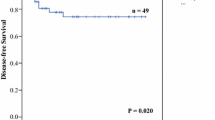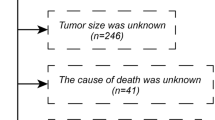Abstract
Purpose
To evaluate the therapeutic role of lymphadenectomy on patients with malignant ovarian germ cell tumor (MOGCT) and to investigate the risk factors of lymph node metastasis.
Methods
Patients of MOGCT between 1988 and 2013 with definite lymph node information were extracted from the Surveillance, Epidemiology, and End Results (SEER) database. Survival curves were estimated using the Kaplan–Meier method, and Cox regression analyses were performed to evaluate the effects of clinical and pathologic variables on survival.
Results
2424 MOGCT patients with information on lymph nodes were included. Of the entire cohort, 46.2% patients received lymphadenectomy. The most common (42.2%) histologic type was teratoma, and 70.6% patients had FIGO stage I disease. Cox proportional model verified that age, grade, and log odds of positive lymph nodes (LODDS) were independent prognostic factors. Subgroup analysis showed that the association between the lymph node resection and better survival in the different age cohort.
Conclusions
Lymphadenectomy is not recommended for children (0–14 years). For patients 40 years of age and older, and for those who have the dysgerminoma type or endodermal sinus type, lymphadenectomy had an outstanding therapeutic role. As a parameter to assess lymph node status, LODDS could be used to classify MOGCTs.



Similar content being viewed by others
References
Smith HO, Berwick M, Verschraegen CF, Wiggins C, Lansing L, Muller CY, Qualls CR (2006) Incidence and survival rates for female malignant germ cell tumors. Obstet Gynecol 107(5):1075–1085. https://doi.org/10.1097/01.AOG.0000216004.22588.ce
Arora RS, Alston RD, Eden TO, Geraci M, Birch JM (2012) Comparative incidence patterns and trends of gonadal and extragonadal germ cell tumors in England, 1979 to 2003. Cancer 118(17):4290–4297. https://doi.org/10.1002/cncr.27403
Jung KW, Won YJ, Oh CM, Kong HJ, Lee DH, Lee KH (2017) Prediction of cancer incidence and mortality in korea. Cancer Res Treat 49(2):306–312. https://doi.org/10.4143/crt.2017.130
Vazquez I, Rustin GJ (2013) Current controversies in the management of germ cell ovarian tumours. Curr Opin Oncol 25(5):539–545. https://doi.org/10.1097/01.cco.0000432609.39293.77
Parkinson CA, Hatcher HM, Ajithkumar TV (2011) Management of malignant ovarian germ cell tumors. Obstet Gynecol Surv 66(8):507–514. https://doi.org/10.1097/OGX.0b013e318234ede9
Murugaesu N, Schmid P, Dancey G, Agarwal R, Holden L, McNeish I, Savage PM, Newlands ES, Rustin GJ, Seckl MJ (2006) Malignant ovarian germ cell tumors: identification of novel prognostic markers and long-term outcome after multimodality treatment. J Clin Oncol Off J Am Soc Clin Oncol 24(30):4862–4866. https://doi.org/10.1200/jco.2006.06.2489
Feldman DR, Voss MH, Jacobsen EP, Jia X, Suarez JA, Turkula S, Sheinfeld J, Bosl GJ, Motzer RJ, Patil S (2013) Clinical features, presentation, and tolerance of platinum-based chemotherapy in germ cell tumor patients 50 years of age and older. Cancer 119(14):2574–2581. https://doi.org/10.1002/cncr.28025
Gershenson DM (2012) Current advances in the management of malignant germ cell and sex cord-stromal tumors of the ovary. Gynecol Oncol 125(3):515–517. https://doi.org/10.1016/j.ygyno.2012.03.019
La Torre M, Nigri G, Petrucciani N, Cavallini M, Aurello P, Cosenza G, Balducci G, Ziparo V, Ramacciato G (2014) Prognostic assessment of different lymph node staging methods for pancreatic cancer with R0 resection: pN staging, lymph node ratio, log odds of positive lymph nodes. Pancreatol Off J Int Assoc Pancreatol (IAP) 14(4):289–294. https://doi.org/10.1016/j.pan.2014.05.794
Chen LJ, Chung KP, Chang YJ, Chang YJ (2015) Ratio and log odds of positive lymph nodes in breast cancer patients with mastectomy. Surg Oncol 24(3):239–247. https://doi.org/10.1016/j.suronc.2015.05.001
Riediger H, Kulemann B, Wittel U, Adam U, Sick O, Neeff H, Hoppner J, Hopt UT, Makowiec F (2016) Prognostic role of log odds of lymph nodes after resection of pancreatic head cancer. J Gastrointest Surg Off J Soc Surg Aliment Tract 20(10):1707–1715. https://doi.org/10.1007/s11605-016-3200-5
Song YX, Gao P, Wang ZN, Tong LL, Xu YY, Sun Z, Xing CZ, Xu HM (2011) Which is the most suitable classification for colorectal cancer, log odds, the number or the ratio of positive lymph nodes? PLoS ONE 6(12):e28937. https://doi.org/10.1371/journal.pone.0028937
Ozawa T, Ishihara S, Sunami E, Kitayama J, Watanabe T (2015) Log odds of positive lymph nodes as a prognostic indicator in stage IV colorectal cancer patients undergoing curative resection. J Surg Oncol 111(4):465–471. https://doi.org/10.1002/jso.23855
Xu XL, Cheng H, Tang MS, Zhang HL, Wu RY, Yu Y, Li X, Wang XM, Mai J, Yang CL, Jiao L, Li ZL, Zhong ZM, Deng R, Li JD, Zhu XF (2017) A novel nomogram based on LODDS to predict the prognosis of epithelial ovarian cancer. Oncotarget 8(5):8120–8130. https://doi.org/10.18632/oncotarget.14100
Li J, Wu X (2016) Current strategy for the treatment of ovarian germ cell tumors: role of extensive surgery. Curr Treat Options Oncol 17(8):44. https://doi.org/10.1007/s11864-016-0416-2
Nasioudis D, Minis E, Chapman-Davis E, Frey MK, Caputo TA, Witkin SS, Holcomb K (2019) Minimally invasive staging of apparent stage I malignant ovarian germ cell tumors: prevalence and outcomes. J Minim Invasive Gynecol 26(3):471–476. https://doi.org/10.1016/j.jmig.2018.05.021
Park JY, Kim DY, Suh DS, Kim JH, Kim YM, Kim YT, Nam JH (2016) Outcomes of surgery alone and surveillance strategy in young women with stage I malignant ovarian germ cell tumors. Int J Gynecol Cancer Off J Int Gynecol Cancer Soc 26(5):859–864. https://doi.org/10.1097/igc.0000000000000702
Di Re F, Baiocchi G (2000) Value of lymph node assessment in ovarian cancer: status of the art at the end of the second millennium. Int J Gynecol Cancer Off J Int Gynecol Cancer Soc 10(6):435–442
Qin B, Xu W, Li Y (2020) The impact of lymphadenectomy on prognosis and survival of clinically apparent early-stage malignant ovarian germ cell tumors. Jpn J Clin Oncol 50(3):282–287. https://doi.org/10.1093/jjco/hyz180
Qin B, Xu W, Li Y (2019) Are omentectomy and lymphadenectomy necessary in patients with apparently early-stage malignant ovarian germ cell tumors? Int J Gynecol Cancer Off J Int Gynecol Cancer Soc. https://doi.org/10.1136/ijgc-2018-000078
Chen Y, Ning Y, Zhang Q, Xie Y (2018) Prognostic impact of lymphadenectomy in different stages of malignant germ cell tumor of the ovary based on propensity score matching. Comb Chem High Throughput Screen 21(9):652–661. https://doi.org/10.2174/1386207322666181220121836
Zhao T, Zhang H, Liu Y, Jiang H, Wang X, Lu Y (2016) The role of staging surgery in the treatment of apparent early-stage malignant ovarian germ cell tumours. Aust NZ J Obstetr Gynaecol 56(4):398–402. https://doi.org/10.1111/ajo.12468
Mahdi H, Swensen RE, Hanna R, Kumar S, Ali-Fehmi R, Semaan A, Tamimi H, Morris RT, Munkarah AR (2011) Prognostic impact of lymphadenectomy in clinically early stage malignant germ cell tumour of the ovary. Br J Cancer 105(4):493–497. https://doi.org/10.1038/bjc.2011.267
Chatchotikawong U, Ruengkhachorn I, Leelaphatanadit C, Phithakwatchara N (2015) 8-year analysis of the prevalence of lymph nodes metastasis, oncologic and pregnancy outcomes in apparent early-stage malignant ovarian germ cell tumors. Asian Pac J cancer prev APJCP 16(4):1609–1613
Yang ZJ, Liu ZC, Wei RJ, Li L (2016) An analysis of prognostic factors in patients with ovarian malignant germ cell tumors who are treated with fertility-preserving surgery. Gynecol Obstet Invest 81(1):1–9. https://doi.org/10.1159/000381771
Nasioudis D, Mastroyannis SA, Latif NA, Ko EM (2020) Trends in the surgical management of malignant ovarian germcell tumors. Gynecol Oncol 157(1):89–93. https://doi.org/10.1016/j.ygyno.2020.01.033
Lin KY, Bryant S, Miller DS, Kehoe SM, Richardson DL, Lea JS (2014) Malignant ovarian germ cell tumor—role of surgical staging and gonadal dysgenesis. Gynecol Oncol 134(1):84–89. https://doi.org/10.1016/j.ygyno.2014.05.003
Mangili G, Sigismondi C, Gadducci A, Cormio G, Scollo P, Tateo S, Ferrandina G, Greggi S, Candiani M, Lorusso D (2011) Outcome and risk factors for recurrence in malignant ovarian germ cell tumors: a MITO-9 retrospective study. Int J Gynecol Cancer Off J Int Gynecol Cancer Soc 21(8):1414–1421. https://doi.org/10.1097/IGC.0b013e3182236582
Matei D, Brown J, Frazier L (2013) Updates in the management of ovarian germ cell tumors. Am Soc Clini Oncol edu book ASCO Am Soc Clin Oncol Meet. https://doi.org/10.1200/EdBook_AM.2013.33.e210
Lin X, Wu D, Zheng N, Xia Q, Han Y (2017) Gonadal germ cell tumors in children: a retrospective review of a 10-year single-center experience. Medicine 96(26):e7386. https://doi.org/10.1097/md.0000000000007386
Kleppe M, Amkreutz LC, Van Gorp T, Slangen BF, Kruse AJ, Kruitwagen RF (2014) Lymph-node metastasis in stage I and II sex cord stromal and malignant germ cell tumours of the ovary: a systematic review. Gynecol Oncol 133(1):124–127. https://doi.org/10.1016/j.ygyno.2014.01.011
Kumar S, Shah JP, Bryant CS, Imudia AN, Cote ML, Ali-Fehmi R, Malone JM Jr, Morris RT (2008) The prevalence and prognostic impact of lymph node metastasis in malignant germ cell tumors of the ovary. Gynecol Oncol 110(2):125–132. https://doi.org/10.1016/j.ygyno.2008.04.022
Park JY, Kim DY, Suh DS, Kim JH, Kim YM, Kim YT, Nam JH (2017) Analysis of outcomes and prognostic factors after fertility-sparing surgery in malignant ovarian germ cell tumors. Gynecol Oncol 145(3):513–518. https://doi.org/10.1016/j.ygyno.2017.03.023
Frazier AL, Hale JP, Rodriguez-Galindo C, Dang H, Olson T, Murray MJ, Amatruda JF, Thornton C, Arul GS, Billmire D, Shaikh F, Pashankar F, Stoneham S, Krailo M, Nicholson JC (2015) Revised risk classification for pediatric extracranial germ cell tumors based on 25 years of clinical trial data from the United Kingdom and United States. J Clin Oncol Off J Am Soc Clin Oncol 33(2):195–201. https://doi.org/10.1200/jco.2014.58.3369
Elashry R, Hemida R, Goda H, el Abdel-Hady S (2013) Prognostic factors of germ cell and sex cord-stromal ovarian tumors in pediatric age: 5 years experience. J Exp Ther Oncol 10(3):181–187
Solheim O, Gershenson DM, Trope CG, Rokkones E, Sun CC, Weedon-Fekjaer H, Fossa SD (2014) Prognostic factors in malignant ovarian germ cell tumours (The surveillance, epidemiology and end results experience 1978–2010). Eur J Cancer 50(11):1942–1950. https://doi.org/10.1016/j.ejca.2014.03.288
Harlan LC, Hankey BF (2003) The surveillance, epidemiology, and end-results program database as a resource for conducting descriptive epidemiologic and clinical studies. J Clin Oncol Off J Am Soc Clin Oncol 21(12):2232–2233. https://doi.org/10.1200/jco.2003.94.023
Acknowledgements
This study is sponsored by grants from Shanghai Sailing Program (No.16YF1401100 and No.19YF1404300) and Natural Science Foundation of Shanghai (No.17ZR1403500) and Natural Science Foundation of China (No.81802596).
Funding
This study was funded by Science and Technology Commission of Shanghai Municipality (grant numbers 16YF1401100 and 19YF1404300), the Natural Science Foundation of Shanghai (grant numbers 17ZR1403500), and National natural science foundation of China (81802596).
Author information
Authors and Affiliations
Contributions
JY Wang: project development, data collection, data analysis, and manuscript writing; X Lu: project development, data management, and manuscript editing; RF Chen: project development and manuscript editing; J Li: data collection or management.
Corresponding author
Ethics declarations
Conflict of interest
Author Jieyu Wang declares that she has no conflict of interest. Author Ruifang Chen declares that he/she has no conflict of interest. Author Jun Li declares that she has no conflict of interest. Author Xin Lu declares that she has no conflict of interest.
Ethical approval
All procedures performed in studies involving human participants were in accordance with the ethical standards of the institutional and/or national research committee and with the 1964 Helsinki declaration and its later amendments or comparable ethical standards.
Informed consent
Informed consent was obtained from all individual participants included in the study.
Additional information
Publisher's Note
Springer Nature remains neutral with regard to jurisdictional claims in published maps and institutional affiliations.
The therapeutic standards for malignant ovarian germ cell tumors are still confusing. This population-based study showed some pathological types and older age appear to be associated with the necessity of operating lymphadenectomy.
Electronic supplementary material
Below is the link to the electronic supplementary material.
404_2020_5772_MOESM1_ESM.tif
Additional Fig. 1 OS of patients divided by clinicopathologic characteristics. Endodermal sinus tumor-EST; Embryonal carcinoma-EC; Mixed germ cell tumor-MGCT; Struma ovarii-SO; Single-never married-SNM (TIF 879 kb)
404_2020_5772_MOESM2_ESM.tif
Additional Fig. 2 CSS of patients divided by clinicopathologic characteristics. Abbreviations: Endodermal sinus tumor-EST; Embryonal carcinoma-EC; Mixed germ cell tumor-MGCT; Struma ovarii-SO; Single-never married-SNM (TIF 891 kb)
404_2020_5772_MOESM4_ESM.docx
Additional Table 2 CSS and OS of patients with malignant germ cell tumors based on clinico-pathological characteristics (DOCX 22 kb)
Rights and permissions
About this article
Cite this article
Wang, J., Chen, R., Li, J. et al. The individualized significance of lymphadenectomy across all age groups and histologies in malignant ovarian germ cell tumors. Arch Gynecol Obstet 302, 1441–1450 (2020). https://doi.org/10.1007/s00404-020-05772-3
Received:
Accepted:
Published:
Issue Date:
DOI: https://doi.org/10.1007/s00404-020-05772-3




